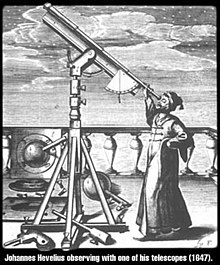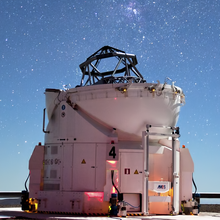Telescope
A telescope is a device used to observe distant objects by their emission, absorption, or reflection of electromagnetic radiation.
Nowadays, the word "telescope" is defined as a wide range of instruments capable of detecting different regions of the electromagnetic spectrum, and in some cases other types of detectors.
The word telescope was coined in 1611 by the Greek mathematician Giovanni Demisiani for one of Galileo Galilei's instruments presented at a banquet at the Accademia dei Lincei.
The root of the word is from the Ancient Greek τῆλε, tele 'far' and σκοπεῖν, skopein 'to look or see'; τηλεσκόπος, teleskopos 'far-seeing'.
[6][7] The idea that the objective, or light-gathering element, could be a mirror instead of a lens was being investigated soon after the invention of the refracting telescope.
[8] The potential advantages of using parabolic mirrors—reduction of spherical aberration and no chromatic aberration—led to many proposed designs and several attempts to build reflecting telescopes.
[9] In 1668, Isaac Newton built the first practical reflecting telescope, of a design which now bears his name, the Newtonian reflector.
The largest reflecting telescopes currently have objectives larger than 10 meters (33 feet), and work is underway on several 30–40m designs.
Even if a wavelength is observable from the ground, it might still be advantageous to place a telescope on a satellite due to issues such as clouds, astronomical seeing and light pollution.
Telescopes such as TRACE and SOHO use special mirrors to reflect extreme ultraviolet, producing higher resolution and brighter images than are otherwise possible.
Unlike an optical telescope, which produces a magnified image of the patch of sky being observed, a traditional radio telescope dish contains a single receiver and records a single time-varying signal characteristic of the observed region; this signal may be sampled at various frequencies.
Radio telescopes are also used to collect microwave radiation, which has the advantage of being able to pass through the atmosphere and interstellar gas and dust clouds.
[24][25] An optical telescope gathers and focuses light mainly from the visible part of the electromagnetic spectrum.
For the image to be observed, photographed, studied, and sent to a computer, telescopes work by employing one or more curved optical elements, usually made from glass lenses and/or mirrors, to gather light and other electromagnetic radiation to bring that light or radiation to a focal point.
X-ray and Gamma-ray telescopes are usually installed on high-flying balloons[44][45] or Earth-orbiting satellites since the Earth's atmosphere is opaque to this part of the electromagnetic spectrum.







